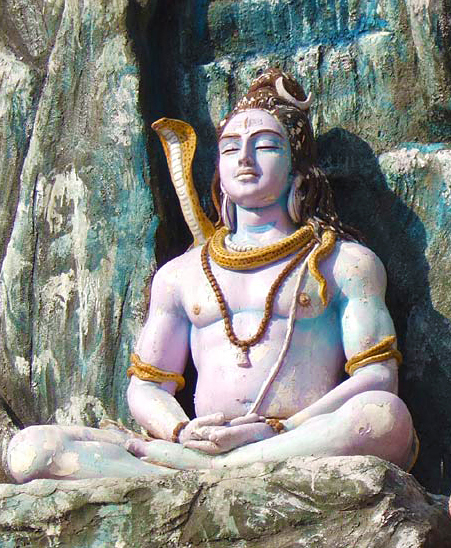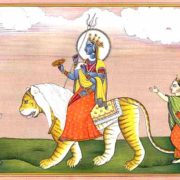8 Limbs of Yoga: Yamas
This article is the second of an eight part series. It will present the second limb: yama (outward attitude and behavior) of the 8-fold path of Raja yoga.
It is a widely held Hindu belief that we are all just characters in one of God’s dreams. The eight limbs (angas) detail a methodical approach by which we can awaken within that dream. Ashta-anga-yoga has been specifically devised over many millennia with the sole intention of leading us to the highest possible state of human potential, God-Realization.
The Yamas: What We Think We Create
The yamas are the first limb of the eightfold yogic path taught by Patanjali. They consist of moral observances, which form the very foundation of spiritual discipline. We use the yamas as a guide for how we deal with the outer world, allowing our behavior and relationships to reflect an attitude of compassion. According to the Yoga Sutra there are five yamas:
- Ahimsa or non-harming
- Satya or truthfulness
- Asteya or nonstealing
- Brahmacarya or chastity
- Aparigraha or greedlessness.
These constitute the maha-vrata or ‘great vow’ of the yogin.
Ahimsa, nonviolence, means more than just the absence or negation of violence. Ahimsa is the practice of kindness in all thought, speech and action, developing a considerate attitude toward ourselves first and then extending benevolence outward in our behavior toward others. To effectively practice ahimsa we need to confront the source of violent impulses, fear and anger. Both fear and anger result in a contraction of our consciousness, isolating us from union with divine energy. Anger pulls a person’s vibration down and is an extremely wasteful expenditure of accumulated spiritual merit. In Buddhist teachings patience is recommended as a countermeasure for anger. However, being patient is much easier in theory than in practice, which is why they call it a practice.
Fear and anger often arise when we are not firmly established in the present. Fear stems from apprehension of a future event, while the source of anger is frequently an inability to let go of something in our past. Gratitude is a strong medicine for both. Negativity and gratitude cannot co-exist in the same space.
Perhaps the most formidable fear-obstacle we will inevitably face is our own death. Knowing that the end of this body is not the end of our existence is essential for developing the trust and surrender necessary to overcome our fear of death. The deeper we delve into our yoga practice, the more directly we can experience God and gain that knowledge.
Satya is the practice of truthfulness. It has been said that, “if you always speak the truth, everything you say will come true.” This means that truth is inherently powerful. When we only speak words we know to be true, we align ourselves with the vibration of creation. In meditation, when our mind is still, we can ‘hear’ the vibration of truth. It’s a feeling – a ‘knowing’ that is beyond words. For the yogi, the origin of truthful speech and action is truthful thought. Those who cause harm out of ignorance are less culpable than those who know what is right and still act otherwise. There is no value in knowing truth unless we act in truth.
Asteya addresses more than just non-stealing, it also means not coveting and not misusing the trust or confidence of another for our own personal gain. “The world has enough for every man’s need, but not every man’s greed.” (Mahatma Ghandhi).
In the west we tend to spend the first half of our life running around like crazed squirrels, gathering up as many nuts as we can find, not appreciating what is happening in the present moment. If we’re “successful” in accumulating, we then spend the second half of our life worrying about who’s going to take our nuts away. When we take more of the world’s resources than we can use, in a sense we are taking what is not ours. Giving away what we don’t need or use, recycling Mother Earth’s precious resources and performing acts of selfless service are all proactive ways in which we can cultivate asteya.
Brahmacharya is the containment of sexual energy for its conscious use. This is not necessarily instruction to choke off a natural urge from an outside-in approach, but to become aware of and contain all sexual energy down to the subtle level of thought. A person in a monogamous relationship or marriage can still be practicing brahmacharya if they keep their sexual energy within that closed circle. When we see a person, rather than negate our natural instincts, we can try to see them from the perspective of all of our chakras, not just the lower three. As yogis we aspire to look beyond the impermanent exterior to that which is eternal.
In the strictest literal sense, brahmacharya means the practice of celibacy. All of the yogin’s physical and psychic energy is directed towards the divine. Sexual energy is pulled upward from the lower to the higher chakras, fueling the spiritual growth and ultimate awakening of the yogi. Qualities in another person such as charisma, brilliance or artistry are in fact sexual energies transmuted. The yogic practices are designed to ignite and increase this energy, which by means of the yamas and niyamas, the yogi channels toward kindness away from ego.
Aparigraha, greedlessness, is a form of asteya and perhaps the most difficult yama for westerners to employ. It means ‘non-hoarding’ or not keeping more than one needs. To a sadhu in India, that would mean not possessing more than a loin cloth, a blanket and a bowl. To a westerner the line between “need” and “want” can often be very fuzzy
So how does a contemporary western yogi understand and practice aparigraha? Perhaps by giving away what is not being utilized. Our giving can also extend beyond the material so that we are not hoarding our caring or compassion for others either. It’s helpful to recognize all of energy as a flow; if one stops the flow of giving, one also impedes the flow of receiving
Through the practice of yama and niyama, we become channels for the good of the universe. Connecting with the truth residing in each of our hearts, connects us with all that is.
Loka Samasta Sukhino Bhavantu ~ May all beings be happy and at peace.
*{published Jan/Feb 2006 issue of ‘LA Yoga & Ayurveda Magazine’, by Sydney and Kevin Light}












Great articles! I found the information presented in a way that I can use. Thank you. Looking forward to the next…
Thank you so much for your reply! We strive to give everyone something they can use to benefit their lives. Best Regards~ HH